18-Year-Old Hero
Tabitha Bell, Positive Possibilities
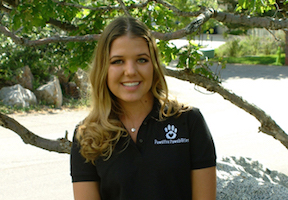 Born with Muscular Dystrophy, Tabitha Bell was told she would need a wheel chair by the time she was 12. Instead, she got a balance & brace service dog. The human/dog partnership was so successful that she decided to start her own non-profit to help match service dogs with those that may not be able to afford the $10,000 entry level. Tabitha tells us that she's working on matching a 6-year old diabetic with a dog that can alert someone when blood sugar spikes.
Born with Muscular Dystrophy, Tabitha Bell was told she would need a wheel chair by the time she was 12. Instead, she got a balance & brace service dog. The human/dog partnership was so successful that she decided to start her own non-profit to help match service dogs with those that may not be able to afford the $10,000 entry level. Tabitha tells us that she's working on matching a 6-year old diabetic with a dog that can alert someone when blood sugar spikes.
When she was 12, Tabitha Bell's orthopedic surgeon told her that she would be in a wheelchair by the time she was in high school, At that time, she was barely walking as it was, but she didn't want to be in a wheelchair. She was living in San Diego, California, near camp Pendleton. There, they had started to use balance & embrace dogs for a lot of the returning veterans who had disabilities like partial paralysis. Tabitha liked to ride horses and had been around dogs her whole life. Even at that young age, she knew how to connect with an animal and get them to do what she needed them to do. Together with her parents, they decided that one of these service dogs might be a good option for her.
Sunny, a 2-year-old German Shepherd, was Tabitha's first service dog who helped her with her balance. To do this, Sunny would wear a harness on his back. It was similar to the harness that guide dogs wear to help the blind. However, the handle is just a little bit shorter to give you more stability on the dog's back. But they're not really like a cane where you balance on them and press down on them. They're more of like a counterbalance. So if she goes to fall one way, her dog can pull her back the other way.
Last year at the age of 18, Tabitha was been named a winner of the 2018 Gloria Barron Prize for Young Heroes. Each year, the Barron Prize celebrates 25 inspiring, public-spirited young people from across the U.S. and Canada who have made a significant positive difference to people and the environment. Fifteen top winners each receive $10,000 to support their service work or higher education.
At age 13, Tabitha founded Pawsitive Pawsibilities, a non-profit that provides service dogs free of charge to people with physical disabilities who can't afford one. In the past five years, she has raised more than $150,000 to place nine dogs that are helping children and adults conquer the challenges of paralysis, cerebral palsy and PTSD (Post Traumatic Stress Disorder).
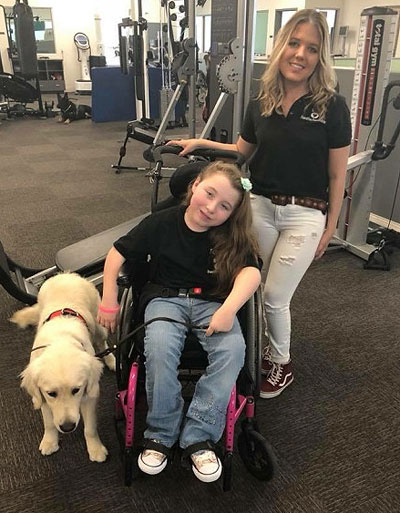 When Tabitha first brought her service dog into the orthopedic surgeon who told her that she would be in a wheelchair by high school, he wondered if a dog could be more helpful to her than arm crutches. She told the surgeon she didn't know, and that he would have to see for himself. She then proceeded to walk down a hallway barefoot, which she could never have done before, especially without the help of her mom. Her surgeon was astounded and said that he needed at least 20 more of these dogs. However, service dogs run about $10,000 to $20,000 depending on who you go through, but that's kind of the average range.
When Tabitha first brought her service dog into the orthopedic surgeon who told her that she would be in a wheelchair by high school, he wondered if a dog could be more helpful to her than arm crutches. She told the surgeon she didn't know, and that he would have to see for himself. She then proceeded to walk down a hallway barefoot, which she could never have done before, especially without the help of her mom. Her surgeon was astounded and said that he needed at least 20 more of these dogs. However, service dogs run about $10,000 to $20,000 depending on who you go through, but that's kind of the average range.
Unfortunately, most people who need a service dog have a lot of other medical bills that they have to pay and insurance will not cover a service dog even though they're a medical device.
Because of this, Tabitha thought she should start something to help other people. When she first started Pawsitive Pawsibilities, her plan was maybe to pay for one service dog throughout her high school career. To date, she has raised over $150,000 and has been able to place 10 dogs.
Recently, Tabitha worked on getting a six-year-old diabetic girl a service dog. The little girl finally met her dog named Curly, who is being trained by the Diabetic Alert Dogs of America.
What does a diabetic service dog do? They're trained to sense when you are either having low blood sugar or high blood sugar. It's actually pretty easy to train the dogs, because when you are going low or high, you let off of pheromone. To train the dog, you give the trainers the clothes that someone was wearing when they had one of those episodes. They also start putting this scent on things. One of the diabetic alert dogs was trained where the only way he could get his dinner was if he was able to figure out this smell. To do this, they would put out three bowls and the bowl that had the scent would open to his dog food.
These dogs are extremely smart, so they are taught beyond sniffing out just the highs and lows, because this little girl's blood sugar is very erratic. It goes up and down at very extreme levels and is all over the place. That's the reason why her parents wanted a service dog for her. The previous monitor this little girl had worked off WiFi, which can often times be unpredictable. So the parents wanted to be able to be notified when she was having problems. Before, she had to literally sleep in their bed, because that's the only way they could keep an eye on her. They're hoping that this will be more beneficial. When the dog is ready, it will be trained to press a button that calls for 911 or a button to call the parents. They will even be trained to just bark. There are a lot of different ways for this dog to be trained to alert.
If someone needs a service dog and can't afford one, they can find Tabitha through Facebook, physical therapy places or even doctors. She will then talk to them about what a service dog is and what they would need it for. Tabitha says she tries to scare people out of it, because it is a lot of responsibility to care of a service dog and using one. She should know, because six months into the process with her first service dog, she was about to give up. It wasn't going well and she didn't think she could do it any more. Her dog was tripping her all the time and making her fall down. She said it was crazy. This is because its two personalities trying to work together and you're going to have your rough patches. But, if you're not willing to take it on, everyone needs to know as soon as possible.
On the other hand, if someone clearly seems like they want to take this responsibility on, Tabitha will get in contact with the trainer she uses and they make the final decision. This is because the trainer will know exactly the personalities, what works best and can figure out what the person needs.
After doing this for about 5 years, Tabitha tells us that there was only one family where a service dog didn't work out for them, and that was just because other things got in the way of their life.
Visit Website
Dog's Day Out
Rocky Kanaka, Hidden Heroes
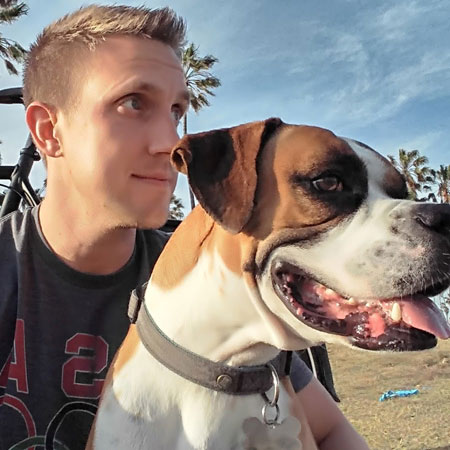 Emmy Nominated TV host Rocky Kanaka is on a mission to find hard-to-adopt rescue dogs their forever home - all while creating a day of fun doggie activities most could only dream of. He chronicles his adventures in a You Tube series called 'Dog's Day Out.'
Emmy Nominated TV host Rocky Kanaka is on a mission to find hard-to-adopt rescue dogs their forever home - all while creating a day of fun doggie activities most could only dream of. He chronicles his adventures in a You Tube series called 'Dog's Day Out.'
Dogs Day Out is a show that Rocky Kanaka created so that he could be closer to the pet loving community. He says it really has a simple premise. To start with, he grabs a dog that is just down and out or is at a shelter or rescue. He then takes them out on the best day he could possibly muster up for them. Not only does he give them the best day, but he also to tries to raise enough awareness so that he can help find that dog at home.
To give a dog the best day out, Rocky tells us he thinks like a dog. So he thinks things that a dog would like. One example of this was Herschel, a giant German shepherd, who had never seen the snow. So Rocky took him to the snow for his first time. Another example was a little Frenchie that loved balls. So he built a giant 20-foot, 10,000, a ball pit so that he could jump in it and chase all the balls. Rocky likes to do things like this that are just over the top that dogs just really love.
Another thing Rocky does is his TV Show, Hidden Heroes. He's done TV shows before and feels he been lucky to be a part of them. But what he really loves about having his show Dog's Day Out on YouTube and Facebook is the pet loving community. They jump in and they get involved. Al lot of the ideas he comes up with are ideas from the fans. They help share a lot of his content so he can work to get these dogs adopted. You can't always donate. You can't always run to a shelter to save a dog. However, it's really easy to hit that share button and you just never know who's going to see that. That share could then end up being that dog's new family.
So far, Rocky has done about 8 to 10 episodes of Dog's Day Out. He's trying to do a lot more, but he really focuses on giving that particular dog all the time and attention it deserves until it finds a home. All of the dogs from his shows were adopted, but one. This dog needed to go to a sanctuary because they needed some extra love, care and support. They were blind and were having behavioral issues. So while the dog wasn't adopted, he is in a much better place now.
It is so hard to decide which dog to take out, according to Rocky. He says this is what keeps him up at night. And the disheartening part is unfortunately there's an unlimited amount of choices for him to pick from. He hasn't really figured that part out yet, because he is a business guy at heart.
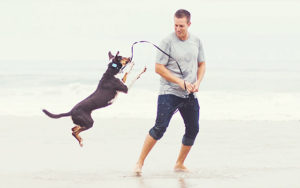 So in this situation, he just kind of lets his heart lead and often times the dog finds him. With regard to Herschel, the dog that had never seen snow, he had been locked up in a backyard and neglected for the first five years of his life when Rocky got to him. He works with a lot of dogs, so he naturally expects in these situations the dog is going to have behavioral issues. They're not going to be trusting and it's going to take time. He doesn't just pick up a dog and run with it. It can sometimes take weeks or months to work with a particular dog.
So in this situation, he just kind of lets his heart lead and often times the dog finds him. With regard to Herschel, the dog that had never seen snow, he had been locked up in a backyard and neglected for the first five years of his life when Rocky got to him. He works with a lot of dogs, so he naturally expects in these situations the dog is going to have behavioral issues. They're not going to be trusting and it's going to take time. He doesn't just pick up a dog and run with it. It can sometimes take weeks or months to work with a particular dog.
But with Herschel, Rocky couldn't believe just how loving, kind and happy he was even though he'd been mistreated for so long. This allowed Rocky to do a lot of "firsts" with him. Herschel even saw the ocean for the first time. Rocky just let him be a German Shepherd. He said it was so rewarding seeing Herschel's over the top reactions to all of this, because it was so much just coming at him that he'd never seen before and it was a real joy getting to be a part of that.
The current pack at Rocky's home includes him and his three dogs, sometimes more if he's fostering. People always leave him comments on social media telling him to adopt the dogs he's showcasing. However, he says he tries to ignore those comments as much as he can cause otherwise he'd go to jail for hoarding dogs!
Visit Website
Black Widow Spiders Poisonous to Pets - Dr. Debbie
 Pet Threats Come in All Sizes
Pet Threats Come in All Sizes
Our doggie family ambled along on our typical morning walk along the community trail. With a family of two Labradors and a Yorkie mix, my crew is always up for fun and they investigate anything and everything.
Sometimes it's a crunchy cockroach snack or the fortunate edible remnant in a discarded candy wrapper. My dogs enjoy the "date game" where they snatch up shriveled fruit fallen from date palms, crunching away before the mom and dad notice. And sometimes it's a half-hearted game of chase with an unsuspecting rabbit. A more gut wrenching episode once involved my Labrador ingesting a rat with tail slipping down his gullet like a piece of spaghetti. My furry kids are professional trouble finders so I try to keep a watchful eye for things that make them go "Oooh," and make me go "Ugh!"
Female Black Widow Spider
While walking along the pedestrian pathway we came upon today's discovery - spiders and lots of them living in the recesses of a block wall. The hairs on my arm stood up as my Yorkie mix approached their lair. I recognize what these spiders are and what could happen to a 16-pound pup.
The long legged spiders were over 1 1/2" in length, black in color with a distinctive orange hourglass mark on its underbelly. Meet the black widow spider, a common arachnid found in every state in the U.S. except Alaska.
The Black Widow Bite
Black widow spiders contain a potent neurotoxin that causes pain, swelling and can lead paralysis. Female black widows are the dangerous ones, while the males rarely ever bite. While some black widow bites go unnoticed, others cause immediate pain at the site or result in pain at the nearest lymph node. Pain intensity reaches its maximum within 1 to 3 hours after the bite, but can last up to 48 hours.
Symptoms of a black widow bite appear within 8 hours after bite an include muscle twitching, restlessness, rigid abdomen and difficulty breathing. Symptoms may result in high blood pressure, a racing heart rate, seizures and collapse. Dogs are more resistant to a black widow bite, but still can suffer serious illness. Cats are very sensitive to the toxins and can suffer fatalities.
Symptoms of black widow bite include:
 - Pain and numbness around bite site
- Pain and numbness around bite site
- Anxiety
- Racing heart rate
- Muscle pain and stiffness, especially abdominal muscles
- Difficulty breathing
- Paralysis
- Seizures
Treatment for Black Widow Spider Bite
Call your veterinarian if you suspect your pet was bitten by a black widow. Initial home emergency care of a black widow bite may include ice packing bite area and oral antihistamines like Benadryl. Your veterinarian will need to see your pet to evaluate and treat the more serious symptoms. Treatment may include medications to control muscle spasms and seizures. Blood pressure and blood sugar are monitored and intravenous fluids may be administered. An antivenin is available for more serious confirmed cases of black widow bite.
Prevention
Avoidance of spider habitats is the best prevention. These eight-legged critters favor dark recesses both indoors and outdoors. Look for cobwebs with a distinctive funnel-shaped opening at the top. And keep a close eye on your dog when out exploring. Inquire about spider control methods with your pest control company.
With pet noses so close to web level, the risk of black widow bites is just natural to being a dog. Our morning spider encounter ended without any drama, thankfully. After one firm "No!" my doggies retreated to unearth some other lucky find. Here's to hoping it doesn't involve any rats or bugs next time.
Featured veterinarian known as "Dr. Debbie" on national pet radio program, Animal Radio. Ebook author of "Yorkshire Terriers: How to Be Your Dog's Best Friend"; "Pugs: How to Be Your Dog's Best Friend"; "Mini Schnauzers: How to Be Your Dog's Best Friend"; and "Shih Tzu: How to Be Your Dog's Best Friend." Dr. Debbie's books.
Visit Website
 The Dogfather's Grooming Tip with Joey Villani
The Dogfather's Grooming Tip with Joey Villani
Home Grooming Kits
Animal Radio's Dogfather Joey Villani warns against casual use of the popular grooming kits available at your pet store. Joey says improperly used, besides giving your dog a bad haircut, you can easily burn their skin. "Take your pets to the groomer instead." Is Joey trying to drum up business for professional groomers nationwide?
It is so easy to purchase a grooming kit, but is it a good idea for you and your pet? Joey says these can be dangerous in the wrong hands. You can find clippers, scissors, brushes and combs, as well as small grooming kits, which everyone can easily use. However, they also sell some grooming kits that contain the same equipment that groomers use. They are selling professional clippers with detachable blades that anyone can buy. The problem with these is that it's easy to cause injury, excessive burning or just cutting of the skin.
Most people buy these professional grooming kits, at around $250, thinking that they are going to save on grooming and eventually the kit will pay for itself. However, groomers are trained to use these, and if you don't know what you're doing, you can cause major injury. What people don't understand, is that with a detachable blade clipper, is that the blade can get very hot, up to 150 degrees plus, because of how it's moving. And you have to pay attention to it. So if you don't use the cooling sprays and the oils, you're going to severely burn your pet. And depending on what type of blades you use, your dog may even end up needing stitches.
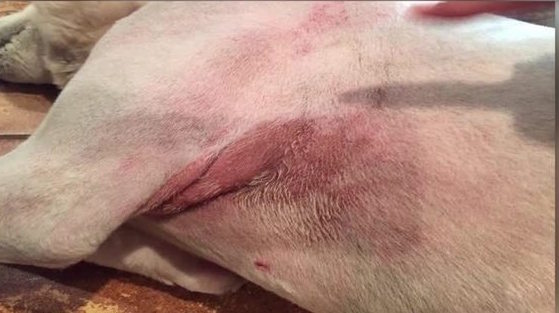 Everyone thinks that they can just pick up a clipper and groom their dog, but this is not true! Judy Francis had never used grooming clippers before but had an opportunity at a trade show. There, they had professional clippers that were for sale as well as a stuffed dog to practice on. When she tried using the clippers on the dog, she butchered it! If it had been a real dog, that dog would have ended up with serious injuries and a high vet bill.
Everyone thinks that they can just pick up a clipper and groom their dog, but this is not true! Judy Francis had never used grooming clippers before but had an opportunity at a trade show. There, they had professional clippers that were for sale as well as a stuffed dog to practice on. When she tried using the clippers on the dog, she butchered it! If it had been a real dog, that dog would have ended up with serious injuries and a high vet bill.
The best thing is to go to your professional groomer and have it done right. Clipping a dog is a trained profession. Don't buy a professional grooming kit, because in the end, it's going to cost you a lot of money, not only for the product but also in vet bills.
Animal Radio News - Lori Brooks
 Traveling With Pets Is Big Business
Traveling With Pets Is Big Business
The travel industry is a huge business. In the US alone, spending on travel hit 1,036 billion in 2017. But a big chunk of travel spending isn't for people; it is for their pets. It's estimated 68-percent of U.S. households, or about 85 million families, have a pet. When those 85 million pet parents hit the road, they can either take their pet with them, or have someone else take care of the furry family member either in their home or a boarding facility. Luckily, businesses are stepping up to meet the demand as childless Millennials, Gen-Xers and Baby-boomer empty nesters are "pet parenting" these days. These include airlines that offer both in-cabin options (for a stiff $125 each way) for small dogs and cats or the option of shipping pets in the cargo hold, for which prices can range from $50 to $500 each way. Over 2 million pets and other live animals are transported by air every year in the United States. Other options include Airbnb, which has many pet-friendly listings. Many hotels also allow animals and the traditional depressing kennel boarding has gone upscale in many areas. What do pet owners do when they can't, or don't want to, take their pet? That's where "pet resorts" or high-end kennels come in such as the D Pet Hotels in Los Angeles, Hollywood, New York, Austin and Scottsdale. They offer boarding, daycare, grooming and even chauffeur and boutique services. For boarding, your dog can pick from a standard suite (4' x 9', dog bed and TV tuned to Animal Planet); a sensational suite (12' x 12 'with twin bed and 32" TV) or uber suite (12' x 22'; a queen bed and 42" TV). A chauffeur will even pick up your dog for their stay at the "hotel" either in a regular vehicle or in a Ferrari, Lamborghini, Bentley, Porsche or Rolls Royce.
 Cat Inherits Fashion Designer's Fortune
Cat Inherits Fashion Designer's Fortune
After the passing of fashion designer Karl Lagerfeld, his cat Choupette, is expected to inherit at least some of the designer's fortune. Prior to his passing, the 85-yr-old Lagerfeld told a French magazine that his cat is an heiress. Lagerfeld had an estimated net worth of up to $300 million and his cat will likely inherit at least a portion of that.
Does Your Dog Get Enough Exercise?
You know your dog needs exercise, but is it getting enough? Probably not, according to the UK's Kennel Club, which says the average adult dog needs at least 30 minutes of exercise each day to stay fit and healthy. But, in rather sad news, a study by the dog food company Forthglade reveals that less than half of dog owners walk their dog on a daily basis, with the average weekday walk being under 20 minutes. Twenty-percent said that's because their dog didn't like wet weather. However, generally the reasons for not walking the dog or not walking him long enough were owners being too tired after work, not having enough time or wanting to stay warm and dry inside. The research also found that dog owners admitted that the main reasons related to time, or a lack of it, where they squeeze in their dog walks around their busy lives by taking a quick walk around the block after work because they're too tired or prefer to watch TV. Little wonder then that more than a third of dog owners confess that their dogs are overweight.
 Dog Mayor Goes To Rainbow Bridge
Dog Mayor Goes To Rainbow Bridge
Duke, the four-term ceremonial dog mayor of a Minnesota town, has gone to the Rainbow Bridge. Duke was a 13-yr-old Great Pyrenees. He made national headlines for being elected the dog mayor of Cormorant Village. Duke was elected to the mayor's seat four times since 2014, acting as the village's ambassador to the public, though he had to retire last year due to failing health.
 Listen to the entire Podcast of this show (#1070)
Listen to the entire Podcast of this show (#1070)





